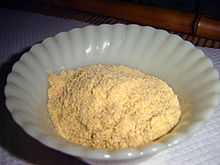Farofa

 |
| This article is part of the series |
| Brazilian cuisine |
|---|
|
Regional cuisines
|
|
Ingredients and types of food
|
|
See also
|
|
|
Farofa is a toasted manioc flour mixture,[1] though variants are made with maize flour (farinha de milho), and flavors can vary. It is eaten in South America and West Africa, especially in Brazil and Nigeria, where a variant is known as gari. It can be found commercially produced and packaged but is often prepared at home based on family recipes. Most recipes will also contain varying amounts of salt, smoked meat, and spices. The consistency of the mixture ranges from large grains the size of cracked bulgur wheat or couscous down to a table-salt-sized powder. Most farofas have a very smoky and slightly salty taste, by and large used to accentuate the taste of meat, particularly barbecued meat and hearty stews.
In Brazil, where farofa is particularly popular, typical recipes call for raw manioc flour to be toasted with butter, salt, and bacon until golden brown. It is an essential accompaniment to feijoada[1] and barbecue. In Brazil, farofa is also used in a stuffing for poultry and other dishes, usually containing raisins, nuts and/or finely chopped sweet fruits like apples and bananas.
Farofa is served alongside the main course and can either be sprinkled on by individual diners to their taste before eating, or eaten as an accompaniment in its own right, as rice is often consumed.
In West Africa, where a variant is known as gari, there are two types; "white" and "yellow" gari. The yellow gari is prepared by frying with the addition of palm oil to give it an orange-like colour; while white garri is fried without palm oil. In the Western parts of Africa, yellow garri is more sought after; hence it is more expensive than the white flavour.[citation needed]
Garri can be eaten without further cooking by placing in a bowl and adding cold water. Sugar or honey is sometimes added to sweeten the taste.It can also be converted into a breakfast cereal by adding powdered milk, chunks of coconut, groundnuts and cashewnuts. Most garri, however, is cooked by adding to boiling water and stirring to make a stiff paste or porridge, which in Nigeria is known as ẹbà. Most parts of Africa where cassava is grown have an equivalent staple dish.
See also
References
- ↑ 1.0 1.1 Zeldes, Leah A. (February 3, 2010). "Eat this! Hearty Brazilian feijoada, just in time for Carnival!". Dining Chicago. Chicago's Restaurant & Entertainment Guide, Inc. Retrieved February 5, 2010.